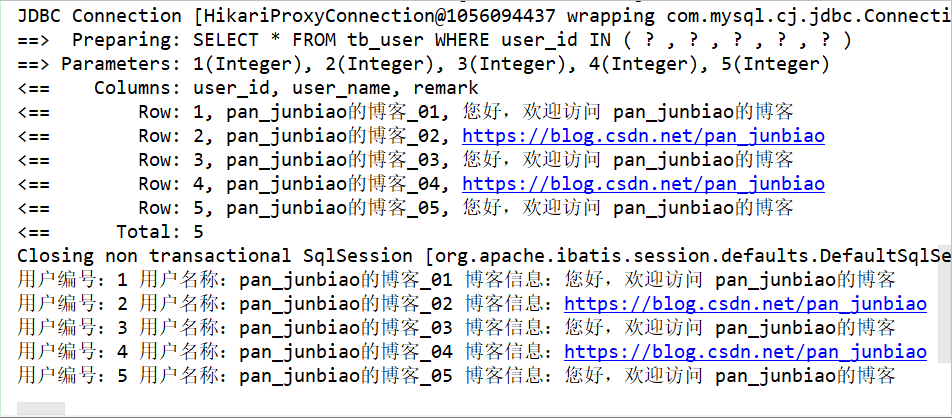在项目的开发中,我们经常需要对数据进行批量的操作,如:批量新增、批量删除等。下面将介绍MyBatis如何实现数据的批量新增和删除操作。
创建UserMapper接口(用户信息Mapper动态代理接口),实现用户信息的批量新增、批量删除、批量查询。
package com.pjb.mapper;
import com.pjb.entity.UserInfo;
import org.apache.ibatis.annotations.Delete;
import org.apache.ibatis.annotations.Insert;
import org.apache.ibatis.annotations.Param;
import org.apache.ibatis.annotations.Select;
import org.springframework.stereotype.Repository;
import java.util.List;
/**
* 用户信息Mapper动态代理接口
* @author pan_junbiao
**/
@Repository
public interface UserMapper
{
/**
* 批量新增用户
*/
@Insert({"<script>",
"INSERT INTO tb_user(user_name,remark) VALUES",
"<foreach collection='userInfoList' item='item' index='index' separator=','>",
"(#{item.userName},#{item.remark})",
"</foreach>",
"</script>"})
public int addUserBatch(@Param("userInfoList") List<UserInfo> userInfoList);
/**
* 批量删除用户
*/
@Delete({"<script>",
"DELETE FROM tb_user WHERE user_id IN",
"<foreach item='id' index='index' collection='array' open='(' separator=',' close=')'>",
"#{id}",
"</foreach>",
"</script>"})
public int deleteUserBatch(int[] userIds);
/**
* 批量获取用户
*/
@Select({"<script>",
"SELECT * FROM tb_user WHERE user_id IN",
"<foreach item='id' index='index' collection='array' open='(' separator=',' close=')'>",
"#{id}",
"</foreach>",
"</script>"})
public List<UserInfo> getUserBatch(int[] userIds);
}1、批量新增
@Autowired
private UserMapper userMapper;
/**
* 批量新增用户
* @author pan_junbiao
*/
@Test
public void addUserBatch()
{
//创建新用户列表
List<UserInfo> userInfoList = new ArrayList<UserInfo>();
userInfoList.add(new UserInfo("pan_junbiao的博客_01","您好,欢迎访问 pan_junbiao的博客"));
userInfoList.add(new UserInfo("pan_junbiao的博客_02","https://blog.csdn.net/pan_junbiao"));
userInfoList.add(new UserInfo("pan_junbiao的博客_03","您好,欢迎访问 pan_junbiao的博客"));
userInfoList.add(new UserInfo("pan_junbiao的博客_04","https://blog.csdn.net/pan_junbiao"));
userInfoList.add(new UserInfo("pan_junbiao的博客_05","您好,欢迎访问 pan_junbiao的博客"));
//执行批量新增操作
int count = userMapper.addUserBatch(userInfoList);
//打印结果
System.out.println("执行结果:成功新增" + count + "条数据!");
}执行结果:

2、批量查询
@Autowired
private UserMapper userMapper;
/**
* 批量获取用户
* @author pan_junbiao
*/
@Test
public void getUserBatch()
{
//用户编号数组
int[] userIds = new int[]{1,2,3,4,5};
//执行批量获取操作
List<UserInfo> userInfoList = userMapper.getUserBatch(userIds);
//打印结果
userInfoList.stream().forEach(System.out::println);
}执行结果:

3、批量删除
@Autowired
private UserMapper userMapper;
/**
* 批量删除用户
* @author pan_junbiao
*/
@Test
public void deleteUserBatch()
{
//用户编号数组
int[] userIds = new int[]{1,2,3,4,5};
//执行批量删除操作
int count = userMapper.deleteUserBatch(userIds);
//打印结果
System.out.println("执行结果:成功删除" + count + "条数据!");
}执行结果:
